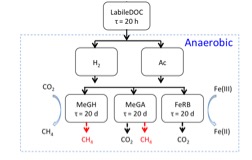A new module for simulating methane was published in Biogeoscience on Sep 12, 2016. The new module, considering carbon cycling and Fe dynamics under anaerobic condition, was developed within the framework of CLM. The methane module is considered as an extension of our previous module published in JGE-Biogeoscience (2015). This work represents a progress of including Feb for simulating methane dynamics, which has been proved being critical for Arctic ecosystems. A preliminary application of the module to permafrost soil microcosms demonstrates its robustness.
Soil organic carbon turnover to CO2 and CH4 is sensitive to soil redox potential and pH conditions. However, land surface models do not consider redox and pH in the aqueous phase explicitly, thereby limiting their use for making predictions in anoxic environments. Using recent data from incubations of Arctic soils, we extend the Community Land Model with coupled carbon and nitrogen (CLM-CN) decomposition cascade to include simple organic substrate turnover, fermentation, Fe(III) reduction, and methanogenesis reactions, and assess the efficacy of various temperature and pH response functions. Incorporating the Windermere Humic Aqueous Model (WHAM) enables us to approximately describe the observed pH evolution without additional parameterization. Although Fe(III) reduction is normally assumed to compete with methanogenesis, the model predicts that Fe(III) reduction raises the pH from acidic to neutral, thereby reducing environmental stress to methanogens and accelerating methane production when substrates are not limiting. The equilibrium speciation predicts a substantial increase in CO2 solubility as pH increases, and taking into account CO2 adsorption to surface sites of metal oxides further decreases the predicted headspace gas-phase fraction at low pH. Without adequate representation of these speciation reactions, as well as the impacts of pH, temperature, and pressure, the CO2 production from closed microcosms can be substantially underestimated based on headspace CO2 measurements only. Our results demonstrate the efficacy of geochemical models for simulating soil biogeochemistry and provide predictive understanding and mechanistic representations that can be incorporated into land surface models to improve climate predictions.
http://www.biogeosciences.net/13/5021/2016/bg-13-5021-2016.html
http://www.biogeosciences.net/13/3735/2016/bg-13-3735-2016.html


